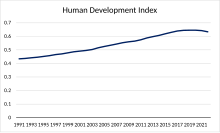

Income inequality in India refers to the unequal distribution of wealth and income among its citizens. According to the CIA World Factbook, the Gini coefficient of India, which is a measure of income distribution inequality, was 35.2 in 2011, ranking 95th out of 157.[2] Wealth distribution is also uneven, with one report estimating that 54% of the country's wealth is controlled by millionaires, the second highest after Russia, as of November 2016.[3] The richest 1% of Indians own 58% of wealth, while the richest 10% of Indians own 80% of the wealth. This trend has consistently increased, meaning the rich are getting richer much faster than the poor, widening the income gap.[3] Inequality worsened since the establishment of income tax in 1922, overtaking the British Raj's record of the share of the top 1% in national income, which was 20.7% in 1939–40.[4]
The latest Oxfam International report titled "Survival of the Richest: The India Story" highlights significant income inequality in India. The richest 1% now own more than 40% of the country's total wealth, while the bottom 50% hold just 3%. The report also reveals a gender pay gap, with female workers earning only 63 paise for every 1 rupee earned by male workers. Additionally, healthcare costs push around 63 million Indians into poverty each year. India has 119 billionaires, whose fortunes have increased almost tenfold over the past decade. The report calls for higher taxes on the wealthy, increased spending on health and education, and measures to address gender and social inequality.[5][6][7] According to Union Government 's own submission to Supreme Court of India, widespread hunger has caused 65% of deaths of children under the age of 5 in 2022.[1]
According to a 2021 report by the Pew Research Center, India has roughly 1.2 billion lower-income individuals, 66 million middle-income individuals, 16 million upper-middle-income individuals, and barely 2 million in the high-income group.[8] According to The Economist, 78 million of India's population are considered middle class as of 2017, if defined using the cutoff of those making more than $10 per day, a standard used by the India's National Council of Applied Economic Research.[9] According to the World Bank, 93% of India's population lived on less than $10 per day, and 99% lived on less than $20 per day in 2021.[10]
- ^ a b "Human Development Index". Human Development Reports. Retrieved April 29, 2023.
- ^ "Country Comparison - Gini Index". cia.gov. Central Intelligence Agency. Archived from the original on 4 June 2011. Retrieved 3 February 2020.
- ^ a b "India second most 'unequal' country after Russia: Report". dailypioneer.com. 4 September 2016. Retrieved 1 March 2019.
- ^ From British Raj to Billionaire Raj, Economic and Political Weekly, 7 October 2017
- ^ https://www.oxfam.org/en/india-extreme-inequality-numbers
- ^ https://indianexpress.com/article/business/economy/indias-richest-1-own-more-than-40-of-total-wealth-oxfam-8384156/
- ^ https://d1ns4ht6ytuzzo.cloudfront.net/oxfamdata/oxfamdatapublic/2023-01/India%20Supplement%202023_digital.pdf?kz3wav0jbhJdvkJ.fK1rj1k1_5ap9FhQ
- ^ "In the pandemic, India's middle class shrinks and poverty spreads while China sees smaller changes". Pew Research Center. Retrieved 18 March 2021.
The poor live on $2 or less daily, low income on $2.01-$10, middle income on $10.01-$20, upper-middle income on $20.01-$50 and high income on more than $50. All dollar figures are expressed in 2011 prices and purchasing power parity dollars, currency exchange rates adjusted for differences in the prices of goods and services across countries.
- ^ "India's missing middle class". The Economist. 11 January 2018. Archived from the original on 10 August 2019. Retrieved 10 August 2019.
- ^ "Poverty and Inequality Platform". World Bank. Archived from the original on 30 January 2023. Retrieved 2022-05-17.